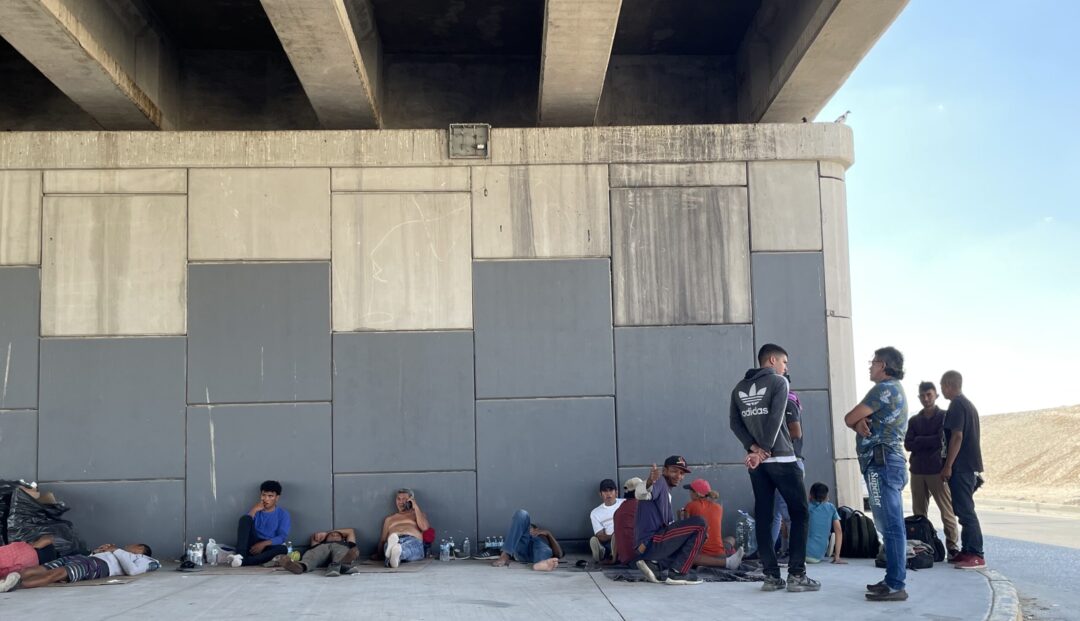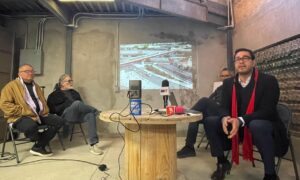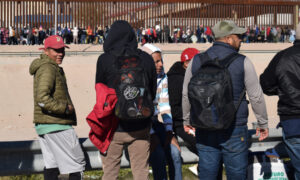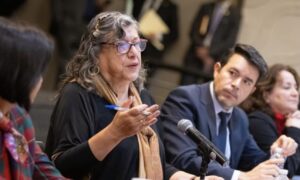By Raul Flores and Rocio Gallegos / La Verdad Juárez
Translation: El Paso Matters
Ciudad Juárez– Melbis and his family sat around a table in the dining room of the Catedral de Nuestra Señora de Guadalupe, the city’s cathedral in downtown. It was their first extended stop after traveling nearly 500 miles, mostly by foot, from Bermejillo in the Mexican state of Durango, where the train they were riding in was stopped.
They arrived in Ciudad Juárez across the border from El Paso on June 7 – just two days after U.S. President Joe Biden signed an executive order restricting asylum for migrants who cross the border illegally. Under the order, the United States will suspend granting asylum to migrants who cross the border between ports of entry when encounters reach a threshold of 2,500 or more daily for seven consecutive days until those encounters decrease to 1,500 daily for a week.
Melbis, 40, and his family left Venezuela hoping to cross the Rio Grande into the United States and surrender to U.S. Border Patrol agents to request asylum. But the new immigration policy changed their plans and now they remain in the city without a clear plan about what they’ll do next.
“I don’t want to go back anywhere, my goal is to enter the United States,” Melbis said after learning about the new policy. “I’m going forward.”
He, his wife and his children are not the only ones rethinking crossing into the United States illegally fearing they’ll lose their chance at asylum. Many migrants said they’ve decided to wait in Juárez before continuing with their plans, some of them looking to the CBP One application to try to make an appointment to cross legally. Others said they won’t likely wait and intend to find a way to cross the border illegally.
The new U.S. policy has increased the presence of migrants in Juárez, with shelters reporting a significant influx of people arriving in search of refuge while more groups of migrants congregate in outdoor areas throughout the city.
But the southern edge of the Rio Grande, which, in recent months, was lined with groups of migrants waiting to take a chance of reaching the United States, is now desolate. Directly across the river from the border wall’s gates 36 and 40, only traces of migrants can be seen: Empty water bottles, blankets and articles of clothing are all that’s left.
Meanwhile, the number of migrants taking refuge in the city’s shelters has increased during the last week, said Pastor Francisco González Palacios, president of the Somos Uno Por Juárez shelter network.
González Palacios, who also coordinates the Vida shelter, commented that the 13 shelters in the network have seen their occupancy rates increase from 30% to 45% in the last week. Together, the shelters can accommodate up to 1,300 people.
“With this (asylum restriction), several people understood that they had to wait for their appointment, which is the most feasible, the most advisable, and that this is the correct way to enter the United States right now,” he said.
The pastor said that he expects the shelters’ occupancy rates to continue to increase in the coming days, though he does not believe they will reach capacity as was the case in 2022 under the Remain in Mexico program.
Still, he’s concerned that many more migrants are on their way north to the city.
“You don’t know the number of people who come on the road every day,” he said. “Juárez is going to collapse.”
Melbis said his family traversed Mexico by train until the convoy was stopped in Durango for four days, where they endured “sun, hunger, rain, everything.”
When it comes to returning migrants to Mexico under Biden’s executive order, Juárez officials said they know little about the policy and federal authorities remain unclear about what process they’re supposed to follow.
The impact that this new order from the United States government will have is not yet fully understood, said Enrique Valenzuela, the general coordinator of the State Population Council of Chihuahua, or COESPO.
He commented that, in Juárez, local authorities are waiting to hear what the “correlated” response will be from the Mexican government.
Meanwhile, the U.S. government announced that it began the process of accelerated deportations and returns to home countries under the policy.
Since the order was put into effect, at least 17 repatriation flights were made to various countries in the Western Hemisphere and “thousands of individuals” have been returned to Mexico, officials with the Department of Homeland Security said during a live Facebook broadcast of the Consulate General of the United States office in Mexico.
The flights and deportations are expected to continue, said Luis Miranda, a DHS spokesman, during the broadcast.
Those rejected will not be eligible for asylum, he said.
“They will be deported to their home country or a third country, face being banned from entering the United States for five years or more, and face possible criminal charges,” he said. “Crossing the United States border between ports of entry is dangerous and illegal.”
While attempts are made to stop illegal migration with new measures, thousands of people continue to travel to Mexico’s northern border to cross into the United States.
Such is the case of Edwin Ramírez, 58, originally from Honduras. He arrived in Juárez with his two children hoping to cross the border to join his wife and two other children, who have been living in the United States since 2011.
At that time, he said, he stayed in his country to tend to a business he ran there. But he decided to migrate after receiving death threats from a criminal group that demanded he pay regular quotas to continue operating his business.
Katherine Pertuz and her cousin from Venezuela planned to meet up with other migrants near the border. They were about to arrive in the state of Chihuahua when they found out about the measure imposed by the U.S. government. Even so, both decided to continue toward the border where they have been for a week.
“We left a lot of money along the way. It cost us a lot to get here, so we have to try because we would lose all the money we have invested,” Pertuz said, adding that they haven’t considered using the CBP One app because of how long they’d have to wait for an appointment.
She was among a group of migrants who sat under an overpass near an avenue that runs parallel to the Rio Grande, trying to escape the scorching heat
Alexander Ardila was also there, along with his wife and son. He said they were forced to leave Colombia due to economic instability, lack of work and political turmoil and corruption. For them, returning to Colombia is not an option, Ardilla said, adding that they’re in limbo and still desire to head north into the United States.
A fellow migrant who identified himself only as Pedro said he knows the feeling. He traveled to the border with his 17-month old baby and his wife, who is five months pregnant. He said the new policy lowered his confidence but didn’t kill his faith that they’d be able to reach the United States and request asylum.
“¡Qué sea lo que dios quiera!” he said in Spanish. “It’s up to God now.”












